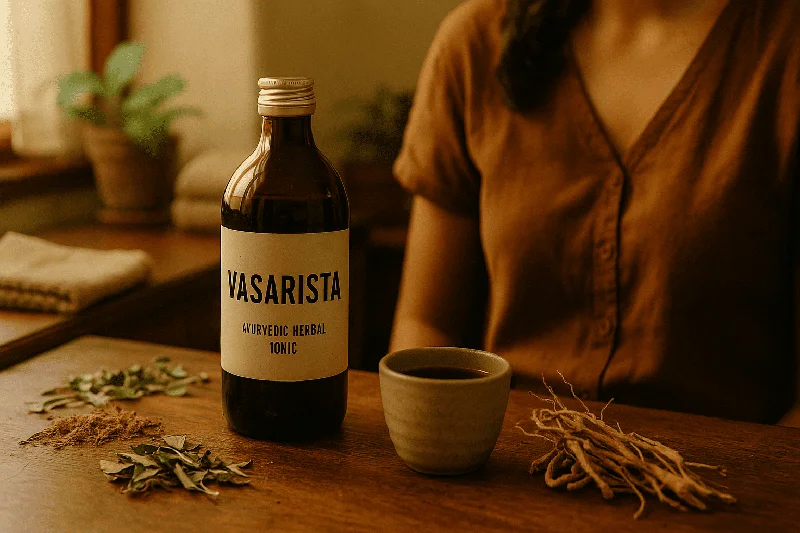आयुर्वेदिक डॉक्टर से प्रश्न पूछें और निःशुल्क या भुगतान मोड में अपनी चिंता की समस्या पर ऑनलाइन परामर्श प्राप्त करें। 2,000 से अधिक अनुभवी डॉक्टर हमारी साइट पर काम करते हैं और आपके प्रश्नों का इंतजार करते हैं और उपयोगकर्ताओं को उनकी स्वास्थ्य समस्याओं को हल करने में प्रतिदिन मदद करते हैं।
अभी हमारे स्टोर में खरीदें
Vasarista: Understanding the Ayurvedic Herbal Tonic

Vasarista, also spelled “Vasarishta,” is an Ayurvedic herbal formulation traditionally prized for its potential respiratory and immune-supporting benefits. In many traditional texts, Vasarista is described as a fermented tonic made primarily from the herb Vasa (Adhatoda vasica), among other botanical ingredients. This herbal mixture has been used for centuries in parts of Asia, particularly in India, for addressing issues related to the respiratory tract. Today, Vasarista is drawing attention globally as scientific studies begin to explore its potential efficacy, safety, and pharmacological properties. In this article, we will delve into the origins of Vasarista, examine what modern research says about its benefits, and provide balanced perspectives from reputable medical sources. Whether you’re a healthcare professional considering integrative therapies or an individual interested in alternative health approaches, this comprehensive guide aims to present science-backed insights and practical tips for understanding Vasarista.
What Is Vasarista?
At its core, Vasarista is an herbal ferment (arishta). In Ayurvedic practice, “arishta” denotes a category of medicinal preparations fermented naturally over weeks or months, enhancing the bioavailability of the herbs involved. The main herb in Vasarista is Adhatoda vasica (also known as Malabar nut), known in traditional medicine for its expectorant, bronchodilatory, and anti-inflammatory properties. The final product is a dark, sweetish-tasting liquid, sometimes compared to a tonic, which can be stored for a relatively long duration without spoilage.
Key Ingredients
-
Adhatoda vasica (Vasa): The cornerstone of this formula, reputed for its respiratory benefits.
-
Spices and Supportive Herbs: Secondary botanicals like ginger, long pepper, and cinnamon are sometimes included to enhance digestion and overall efficacy.
-
Natural Sweeteners: Jaggery or raw sugar is often used to kickstart fermentation and balance the flavor.
By combining these elements, Ayurvedic practitioners aim to create a holistic remedy that addresses multiple facets of health, primarily targeting respiratory well-being.
Traditional Uses and History
From an Ayurvedic standpoint, Vasarista is believed to balance the “Kapha” and “Pitta” doshas, which, in Ayurvedic theory, govern bodily fluids and metabolic processes. Historical Ayurvedic texts describe Vasarista as:
-
An expectorant for managing congestion and cough.
-
A general tonic to improve “prana vaha srotas” (the channels that govern respiration).
-
An aid in alleviating symptoms of seasonal allergies and bronchitis.
Traditional recipes have been preserved in Ayurvedic compendiums such as the Charaka Samhita and Sushruta Samhita. Healers in ancient times passed down these formulations through generations, fine-tuning them to optimize therapeutic benefits.
Scientific Evidence and Modern Research
Pharmacological Properties
Modern pharmacological analyses suggest that Adhatoda vasica contains active compounds like vasicine and vasicinone. These alkaloids have been studied for their possible bronchodilatory and mucolytic effects, potentially aiding in clearing mucus from the respiratory tract. A study published in the Journal of Ethnopharmacology (2020) found that extracts of Adhatoda vasica showed anti-inflammatory activities in animal models, aligning with traditional claims of its respiratory benefits.
Clinical Trials and Observational Studies
While robust, large-scale clinical trials on Vasarista itself are relatively limited, smaller observational studies and case reports hint at possible benefits:
-
Respiratory Infections: In a 2019 pilot study, participants experiencing chronic cough reported reduced symptom severity after taking a Vasarista-like formulation, though larger trials are needed to confirm these findings.
-
Bronchial Asthma: Preliminary research suggests that Adhatoda vasica, the key herb in Vasarista, may help dilate air passages, but the exact impact of the fermented Vasarista preparation on asthma is still under investigation.
-
Immunity and Antioxidant Activity: Some in vitro research indicates that fermented herbal formulas, including Vasarista, could boost antioxidant enzyme levels, but more data is required for definitive conclusions.
For the most current and detailed research, one can search authoritative databases such as PubMed or consult updates from major health organizations. Always cross-check findings with established clinical guidelines from bodies like the World Health Organization (WHO) or recognized medical institutions.
How Is Vasarista Prepared?
Vasarista’s production involves a meticulous process:
-
Herb Selection: Fresh or dried Adhatoda vasica leaves and stems are chosen for potency.
-
Decoction Stage: The herb is boiled in water to extract the soluble active components.
-
Fermentation: The decoction is mixed with a natural sweetener (like jaggery) and often combined with other herbs or spices. This mixture is then left to ferment in closed containers for several weeks.
-
Filtering and Aging: Once fermentation is complete, the liquid is filtered and sometimes aged further to enhance its therapeutic qualities.
This traditional preparation method is believed to increase the bioavailability of the herb’s alkaloids, as fermentation can produce beneficial enzymes and secondary metabolites.
Potential Benefits of Vasarista
Below are some commonly cited benefits in both Ayurvedic texts and emerging scientific discussions:
-
Respiratory Support: May ease symptoms of bronchitis, cough, and mild respiratory congestion.
-
Anti-Inflammatory Effects: Contains compounds like vasicine, which have shown potential anti-inflammatory properties in preliminary research.
-
Immune Modulation: Some fermented products in Ayurveda are considered to strengthen the body’s immune responses, though clinical evidence is limited.
-
Digestive Aid: Traditional practitioners assert that the warming spices used can aid digestion and reduce bloating, though more research is warranted.
Always remember that individual responses can vary significantly, and scientific investigations are ongoing.
Dosage and Safety Considerations
General Guidelines
-
Typical Serving: Most practitioners suggest 15–30 milliliters of Vasarista twice a day, usually after meals. However, this can vary based on individual health needs and the formulation’s concentration.
-
Children and Elderly: Lower dosages are usually recommended for children and older adults. Consultation with a qualified Ayurvedic practitioner or healthcare provider is essential for personalized advice.
Safety Profile
-
Adverse Effects: Side effects from moderate use are uncommon, but mild gastrointestinal discomfort or allergic reactions may occur in sensitive individuals.
-
Drug Interactions: Some herbs may interact with prescription medications. If you’re on anticoagulants, anti-inflammatory drugs, or treatments for chronic conditions like diabetes or hypertension, consult your physician before using Vasarista.
-
Pregnancy and Breastfeeding: Research is limited in these groups, so it’s advisable for pregnant or breastfeeding individuals to seek medical guidance.
Clinical Evidence vs. Traditional Claims
Points of Convergence
-
Both Ayurvedic texts and modern preliminary research support the potential respiratory benefits of Vasarista’s main herb, Adhatoda vasica.
-
Fermentation is widely recognized as a process that can enhance the bioactivity of herbal compounds.
Points of Divergence
-
Most contemporary research focuses on isolated phytochemicals like vasicine, rather than the complete fermented Vasarista product.
-
Long-term effects, safety, and interactions with modern medications are areas where large-scale clinical evidence is still pending.
By comparing traditional knowledge with emerging data, readers can gain a nuanced understanding and set realistic expectations regarding Vasarista’s role in health.
Integrating Vasarista into Modern Healthcare
With growing interest in complementary and alternative medicine, integrative healthcare settings are exploring Ayurvedic preparations like Vasarista. Some physicians and naturopaths recommend it alongside conventional treatments, especially for mild respiratory ailments or as part of a holistic wellness routine.
-
Screening and Assessment: Healthcare providers may assess a patient’s medical history, medications, and overall constitution (in Ayurvedic terms, “Prakriti”) before suggesting Vasarista.
-
Monitoring: When introducing Vasarista, it’s prudent to monitor changes in symptoms, any potential side effects, and overall well-being.
-
Patient Education: Informing patients about the supplement’s preparation, possible benefits, and precautions helps ensure safe and effective use.
Practical Tips for Using Vasarista
-
Start Slow: If you are new to herbal tonics, begin with a smaller dose to observe how your body reacts.
-
Maintain Consistency: Regular use, as guided by a healthcare provider, may be necessary to observe noticeable benefits.
-
Pair with a Balanced Diet: Incorporate nutrient-rich foods, especially those that support respiratory health like ginger, garlic, and green leafy vegetables.
-
Stay Hydrated: Adequate water intake can help the body manage mucus and support detoxification.
Frequently Asked Questions (FAQ)
1. Can I take Vasarista on my own without consulting a doctor?
While Vasarista is generally considered safe for most healthy adults, it’s best to consult a healthcare provider or qualified Ayurvedic practitioner before starting any new supplement, especially if you have underlying health conditions or are on prescription medications.
2. Is there a standard recipe for Vasarista?
The foundational herb is always Adhatoda vasica, but supplementary herbs and spices may differ based on regional variations and the preferences of the traditional practitioner preparing the formula.
3. How long does it take to see results?
Individual responses vary, but many people report noticing changes within a few weeks when Vasarista is taken regularly. For chronic conditions, consistent use under professional guidance is recommended.
4. Is Vasarista suitable for vegetarians and vegans?
Typically, Vasarista is plant-based. However, some manufacturers might add ingredients that are not vegan-friendly. Always check labels or confirm with the product manufacturer.
5. Can I combine Vasarista with other herbal tonics?
It may be possible, but you should seek expert advice to avoid overlapping ingredients, excessive dosages, or potential interactions with medication.
Conclusion
Vasarista stands at the intersection of age-old Ayurvedic wisdom and modern scientific inquiry. Known for its potential respiratory benefits and immune-supporting properties, this herbal formulation has captured the interest of both traditional healers and researchers seeking natural options for managing common ailments. While emerging studies back some of its traditionally claimed benefits, it’s important to approach Vasarista with balanced expectations and to consult qualified healthcare professionals for personalized guidance. If you found this article informative, consider sharing it with friends or colleagues who are exploring Ayurvedic remedies. Feel free to comment with your experiences or questions, and subscribe to stay updated on the latest in holistic health research. By combining traditional knowledge with rigorous scientific investigation, we move closer to making well-informed decisions about the natural therapies that could truly benefit our lives.
Disclaimer: The information provided in this article is for educational purposes only and is not intended to substitute professional medical advice. Consult your doctor or a qualified Ayurvedic practitioner for personalized recommendations regarding the use of Vasarista or any other herbal supplement. Results may vary, and this article does not claim to diagnose, treat, cure, or prevent any disease.
यह लेख वर्तमान योग्य विशेषज्ञों द्वारा जाँचा गया है Dr Sujal Patil और इसे साइट के उपयोगकर्ताओं के लिए सूचना का एक विश्वसनीय स्रोत माना जा सकता है।



